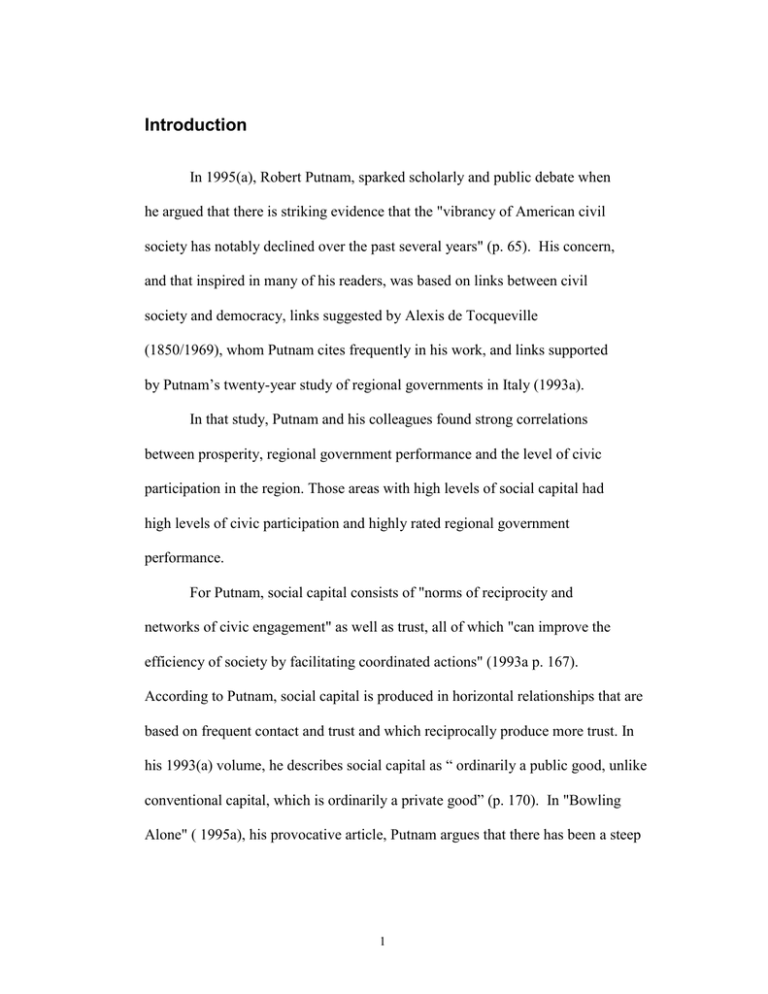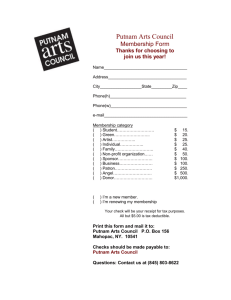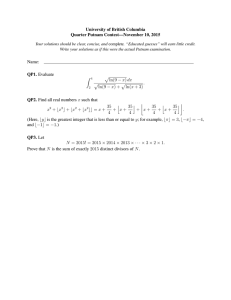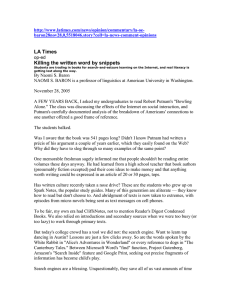Introduction
advertisement

Introduction In 1995(a), Robert Putnam, sparked scholarly and public debate when he argued that there is striking evidence that the "vibrancy of American civil society has notably declined over the past several years" (p. 65). His concern, and that inspired in many of his readers, was based on links between civil society and democracy, links suggested by Alexis de Tocqueville (1850/1969), whom Putnam cites frequently in his work, and links supported by Putnam’s twenty-year study of regional governments in Italy (1993a). In that study, Putnam and his colleagues found strong correlations between prosperity, regional government performance and the level of civic participation in the region. Those areas with high levels of social capital had high levels of civic participation and highly rated regional government performance. For Putnam, social capital consists of "norms of reciprocity and networks of civic engagement" as well as trust, all of which "can improve the efficiency of society by facilitating coordinated actions" (1993a p. 167). According to Putnam, social capital is produced in horizontal relationships that are based on frequent contact and trust and which reciprocally produce more trust. In his 1993(a) volume, he describes social capital as “ ordinarily a public good, unlike conventional capital, which is ordinarily a private good” (p. 170). In "Bowling Alone" ( 1995a), his provocative article, Putnam argues that there has been a steep 1 2 decline in social capital in the United States since the early 1960s. His evidence includes declining membership in and volunteering for the PTA, the League of Women Voters, the Boy Scouts, the Red Cross and other "mainline" civic organizations (p. 69). He correlates this decline with declines in voter turnout and attendance at public meetings, political rallies, and speeches (pp. 67-68). Using both Tocqueville and the findings of his Italian study, Putnam theorizes that an active civil society in which people come into regular contact with others through mutual participation in activities of personal and communal interest, e.g., choral societies, sports clubs, bowling leagues, produces more "social capital" than a society in which interpersonal and non-hierarchical contact is less common. (See Putnam 1993a, 1993 b, 1995a, 1996a.) Putnam's arguments have had a serious impact, not only on scholars, but also on policy makers and the public. In addition to a 1996 debate in the American Prospect, Putnam and his argument became the subject of numerous articles in the popular press and Putnam became an advisor to national policy makers interested in the decline of social capital and the loss of “community.” Like discussion of the decline of social capital, the discussion of community has drawn on Tocqueville, in the latter case a “Tocquevillian” model based on the 18th century New England small town and emphasizing geographical contiguity and relative homogeneity in the creation of community. While the Tocquevillian community may have existed only as an ideal form (Gans 1967), it continues to be 3 invoked, often uncritically (Amidon 1960; Cohen 1960; Coleman 1996; Galston 1996, McCarthy 1996, Skocpol 1996). Bellah, Madsen, Sullivan, Swidler, and Tipton (1985, pp. 38-40) describe a Tocquevillian community as a local community that in the agrarian mid-nineteenth century was still the “basic unit of association, the foundation of both individual dignity and participation” (p. 38). They add: There a civic culture of individual initiative was nurtured through custom and personal ties inculcated by a widely shared Protestant Christianity…Concern for economic betterment was widespread, but it operated within the context of a stillfunctional covenant concern for the welfare of one’s neighbor. In the towns, the competitive individualism stirred by commerce was balanced and humanized by the restraining influences of a fundamentally egalitarian ethic of community responsibility. These autonomous, small-scale communities in the midnineteenth century were dominated by the classic citizens of a free republic, men of middling condition who shared similar economic and social positions and whose ranks less affluent members of the population aspired to enter, often successfully. (Ibid.) While Putnam has consistently addressed the need for and desirability of including all members of society in the exchange of social capital, the Tocquevillian model of community with which his work can easily be associated does not readily accommodate diversity. Similarly, the “mainline,” traditional forms of volunteering and voluntary association, the decline of which provokes much of Putnam’s concern, have been critiqued as having a “roseate Norman Rockwell glow” (Wills 2000, p. 34). 4 Traditionally, voluntary associations have been given impetus by elites who have the time, economic, and educational resources, as well as the connections (i.e., social capital) to get them started (Crawford and Levitt 1999, McCarthy 1990; Skocpol 1996, Van Til 1987, Verba, Schlozman, & Brady 1995). Often those with the time and resources have been middle and upper class women of Northern European extraction, who, at times, in spite of their socioeconomic status have been exploited (Daniels 1988, Ellis and Noyes 1990). At the same time, traditional voluntary associations have mediated between private needs and public policy and goods (Ellis & Noyes 1990; Sills 1957/1980, 1960). Changes in society since 1960 have caused a broadening in definitions of voluntarism (the practice of volunteering and philanthropy1) to include work-related or work-based civic action by, for example, academic elites (DeLaat 1987; Ellis and Noyes 1990). This has happened as the political economy of the "third sector" (voluntary and non-profit) has blended with those of the public (government/civil service) and private (corporate/business) sectors (Reich 1991, Van Til 1987), changing the character and the role of voluntary associations. The blurring of society's three sectors as well as the mingling of civic engagement, civil life, and work, complicate the study of voluntarism, voluntary association, community, and civic engagement. Traditional volunteering in Both “volunteerism” and “voluntarism” have been used to describe participation in voluntary associations. I am using the term “voluntarism” to include both volunteering labor and volunteering funds or in-kind services, i.e., philanthropy. I understand the term to mean the willful contribution of personal resources for a greater good than that of personal gain or interest, and 1 5 traditional voluntary associations was associated with social and economic contexts that no longer exist. The discussion of civil life and civic engagement requires new definitions of volunteering. Similarly, the separate categories of private, public, and third or non-profit sectors; and work life, private life, civil life, and civic engagement do not adequately address the dynamic and heterogeneous nature of economic and social interactions which cross those categories. Just as traditional definitions of volunteering and voluntary associations have become inadequate to describe a changed society, the Tocquevillian model of a stable, geographically contiguous, and essentially homogeneous community characterized by repeated social interactions in a relatively closed network of relations has become inadequate. This traditional model does not take into account diversity, geographic mobility, or geographically distributed communities. The Tocquevillian model does not address repeated social interaction and sustained commitment mediated by modern modes of transportation and communication and motivated by the practice of a shared activity or "intent" to practice. Accounting for diversity, mobility, geographic distribution and shared interests, intentions, and practice requires neo-Tocquevillian models of community that reflect the process of building understanding and social relations across distance and multiple blends of cultures, languages and classes. The concept of a community not defined by traditionally shared space and history is considered by Putnam who invokes Fischer’s “communities of limited without direct economic compensation. I use the term “volunteering” to refer to labor that is neither remunerated nor coerced. 6 liability” and Jackson’s “personal communities” (in Putnam 2000, p. 183). Putnam argues that such communities are fragile and not productive of social connectedness and civic engagement. In this new volume, he argues that these fragile communities do not produce enduring social relations that bridge groups and support the greater good of the community at large. He describes this phenomenon in terms of a more complex discussion of social capital. Rather than viewing social capital as benign, Putnam (2000) notes that social capital can be used malevolently, i.e., the KKK builds strong social relations. Additionally, social capital that is used benevolently can be of either the “bridging” or the “bonding” kind (p. 22). Bonding social capital is inward looking or exclusive. It tends to reinforce identities and homogeneity. It builds solidarity and sounds much like the social relations that Reich (1991) describes as being produced by active volunteers in their own middle and upper class social enclaves. Bridging social capital, on the other hand, is outward looking or inclusive. It “encompasses people across diverse social cleavages” and provides access for “getting ahead” (pp. 22-23). It is this bridging that builds democracy and it is the bridging form of social capital that Putnam sees in decline. The 1996 Putnam debates provoked the present study. As I considered the arguments and Putnam’s evidence of social decline, I was engaged in doing ethnography and participant observation in an ongoing research project that linked university and community in collaborative endeavors to build and sustain informal education programs. In those programs, I saw diverse people working together to 7 build opportunity for children. Often the adults who built these programs worked long hours, many of which were unpaid. I found myself unable to observe these people and agree that they did not volunteer or that they were not civically engaged. Similarly, (and consistent with some of Putnam’s critics), other areas of my life suggested that while people might not be bowling together, they did appear to be “kicking in groups,” as Lemann (1966) suggested. The people I observed and the people Putnam’s critics described engaged in civil association and volunteering, and were apparently civically engaged in layered communities. Through my study, I hoped to better understand the discrepancy between the empirical observations and Putnam’s earlier findings. As I was finishing my study, Putnam published his new volume and addressed some of my concerns as well as his numerous critics. One area where he has changed his argument is that of volunteering and voluntary association. He now acknowledges that not only are these not in decline in the U.S., but rather, they have risen dramatically. So far, Putnam’s new volume has drawn mixed reviews (Nyhan 2000, Talbot 2000, Wilkens 2000, Wills 2000), perhaps because the declines that Putnam describes are more difficult to envision in an atmosphere of economic prosperity. Other issues related to Putnam’s concern with the decline of social capital, declining volunteerism and participation in voluntary associations and disappearing community do continue to be discussed (Crawford and Levitt 1999, Fukuyama 1999, Hesselbein, Goldsmith, Beckhard and Schubert 1998, Schudson 1998). It is to this discussion, that this study makes a contribution. 8 In his body of work, Putnam has drawn on an enormous amount and variety of statistical evidence in order to study the “the evolving social climate” and produce a “review of trends in social capital and civic engagement” (pp. 26-27). Putnam’s study of these phenomena has focused on the broad level of social trends. It is specifically focused on decline of social capital, community, and voluntarism broadly taken. Using Putnam’s broad lens does not permit consideration of individuals and institutions as they engage in the process of building social relations over time. A narrower lens that focuses on individuals and institutions is useful in approaching a question left unanswered in Putnam’s Italian study—How did some regions become areas of social capital and some not? How did traditions of social capital, strong community, and civic engagement begin? What was it that individuals and institutions did to begin the process of building social capital? As Putnam notes, in spite of his extensive research, it is difficult, if not impossible, to reconstruct the historical process of the emergence of social capital in the Italian regions he studied. It is not, however, so difficult to explore that process on the more manageable scale of individuals and institutions in small groups engaged in shared practice, and that has been my project. For a period of four years, I have tracked the development of a new after school, informal education program in Beach Town, CA, the Magical Dimension, in relation to its two predecessors, the Fifth Dimension and La Clase Mágica, two other programs in the same town. All three programs are based on the Fifth Dimension model. The model brings together university and community organizations in a reciprocal arrangement that places not only the institutions, but also their diverse representatives in interest-based contact. In tracking the development of the Magical Dimension and other programs, I focused on the 9 networks of pre-existing relations that supported the emergence of the Magical Dimension and new linkages between it and the other two programs. Very early in the course of my study, the three collaboratively run programs gave rise to an emergent social formation, the Beach Town Coalition for Community Education. The Coalition was constituted by a diverse group of adults who came together in order to sustain and expand the efforts of the three after school programs. The Coalition became the main focus of the present study. In tracking processes of inter-personal and inter-institutional development related to the development of the Magical Dimension and the Coalition, I used ethnographic data gathered during four years of participant observation. I also used ethnographic interviews with adults participating or interfacing with the Magical Dimension (as well as the Fifth Dimension and La Clase Mágica) and the Coalition, and recordings of Coalition meetings. In addition to my own data, I have had access to a large pool of data gathered by researchers engaged in studying the Fifth Dimension and La Clase Mágica. I approached this pool of data as a source of firsthand historical accounts. While each was necessarily subjective, the corpus of accounts in conjunction with the other forms of data provided evidence of trends in the local social arena composed of individuals and the local institutions they represented. This localized case study of inter-institutional and inter-personal development mediated by the Fifth Dimension model provides a very different lens on the rise and the decline of social capital than the broad lens used by Putnam. For example, at this case study level, it is possible to observe the processes of communication and the attendant challenges that diverse individuals and institutions must overcome in order to work together, e.g., the labors of producing social capital. 10 While, I began this study motivated by the desire to understand the process of social capital development, I also wished to explore the challenges involved in building productive cooperation, communication and social relations between diverse persons and diverse institutions such as a university and a non-profit youth club or school. Consequently, I have been guided throughout this study by two questions: What specific communication challenges are involved in developing and sustaining inter-institutional collaboration between diverse institutions? How do these challenges relate to inter-personal and inter-cultural communication? During the course of the study, the unanticipated development of the Coalition provoked my third research question, which is related specifically to civil life and civic engagement: What is the nature of this emergent organization and what motivates the participation of its diverse individuals? My final question involves the model after school program that figured in my questioning of Putnam’s argument. What are the qualities of the Fifth Dimension that bring diverse people together and provoke their sustained participation and voluntarism? In order to address these questions, I have found it useful to bring together analytical tools from two bodies of theory, the sociological literature on civil life and civic engagement into which Putnam writes, and the socio-cultural-historical literature on developmental processes, a literature that initially derives from psychology, but currently draws on that and other social sciences. Socio-cultural-historical theories strive to account for the situatedness of development and the affordances and constraints of social and cultural contexts for development. They assume a social and cultural basis for development and provide 11 theoretically informed categories that can be applied systematically to qualitative data on the level of concrete small groups and institutions and the interactions that constitute them (Cole 1996; Engestrom 1987, 1990; Lave and Wenger 1991; Rogoff 1994). Sociological theories of community, civil life, and civic engagement link individual human motivation and action to the level of broad-based social phenomena or trends (Bellah et al. 1985, 1992; Gans 1967; Putnam 1993a, 1993b, 1995a, 1995b, 1996). Research informed by these latter theories looks at the level of the individual as it relates to the far broader level of social structure. Research informed by socio-cultural-historical theories looks at what constitutes a middle level, that of the individual in communal activity. Socio-cultural-historical theories and research guided by them place strong emphasis on a historical perspective that looks at individual and collective human development as temporally, spatially, and socially situated and changing over time. As such, they add a reciprocal dimension to the relation of individuals to collectives, institutions, and by extension, to social structure. For these reasons, I bring the sociological literature on civil life and civic engagement and the socio-cultural-historical literature on developmental processes together in the analysis of interrelated systems of dynamic inter-personal and interinstitutional relations. Doing so provides a process view that sheds light on the practices of volunteerism, voluntary association, and community building and provides information that analysis at the level of broad social trends leaves obscure. The empirical findings of this study suggest that a hybrid form of bonding/bridging social capital was built in non-traditional communities in a developmental process mediated by the Fifth Dimension model. This developmental process required a commitment to long term engagement by institutions, but not necessarily individual representatives. Long-term institutional 12 engagement was represented by the physical presence of representatives. Continued development of social relations required openness to change on the part of both individuals and institutions. While this may seem to be in contradiction to long term commitment, it is not. The long-term commitment was to presence and flexibility in defining goals and procedures, not to an entrenched plan. Additionally, having individual persons assume the role of “translator” between different institutions and their representatives was essential. The ability to “translate” assumes understanding of institutional and individual perspectives and languages beyond one’s own. Developing that understanding took time, presence, and attention. In this case study, the Fifth Dimension model mediated the development of non-traditional communities and social capital. A basic element of the model is reciprocity between diverse collaborators. Another is a shared frame that not only accepts, but requires diverse content. In other words, the model provided a general outline that was understood by the collaborating individuals and institutions, but the model was open; the content was not set. Therefore, there was both structure and the opportunity to co-develop and co-construct. Another way of looking at this is to say that the shared frame worked at bridging across institutions. The open content provided for bonding within an individual program and individual institutions. It is important to note that the individual members of the non-traditional communities that are described here are diverse in age, gender, socio-economic status and ethno-linguistic background. They do not live in close proximity so that cars and buses, telephones and computers mediate their contact. The members’ participation blended volunteering and work, self-interest and other interest. The formation of the communities themselves and the hybrid form of social capital that 13 developed in these communities was facilitated by a hybrid form of support that drew on public, third sector/non-profit, and private resources. Chapter 1 is a review of the literature on civil life and civic engagement in terms of the problem of generating and sustaining participation. In it, I consider the Putnam debates of 1996 and the nostalgic search for a Tocquevillian community in the face of growing social diversity and changing contexts. After discussion of the concepts of “self-interest rightly understood,” social capital, and attention, an argument for an approach that addresses historical change in associations and their environmental contexts concludes the chapter. Chapter 2 suggests socio-culturalhistorical theories of development as useful tools for considering the emergence and development of community. This chapter offers non-Tocquevillian models of community as well as a system of categories that is useful in analyzing qualitative data across phenomena and across time. Chapter 3 lays out the methods and specific analytical tools used in this thesis. These include Cole’s (1996) “utopian methodology” and meso-genetic approach to studying development by placing “design experiments.” The chapter presents a description of the Fifth Dimension model, a design experiment fundamental to the present study, and provides detail on the use of participant observation, ethnographic methods, and historical methods in tracking development mediated by the Fifth Dimension and in analyzing the data. Chapter 4 contains a narrative description of the development of the Magical Dimension and the Coalition. Data are presented globally--chronologically and in terms of levels of analysis. The levels include the site level, or that of the Magical Dimension and Coalition themselves; the sub-site level, or that of the institutional partners and persons participating in site operation; and the super-site level, or that of the networks of university-community collaboratives inspired by the original 14 projects. Chapter 5 explores the role of community in inter-institutional development, looking at the Coalition’s development in terms of socio-culturalhistorical models of community. This is followed by an argument for a new model of community, community of intent, that is characterized by communication and intent to continue coming together. The chapter concludes with the argument that a community of intent, while emergent and fragile, can produce social capital. Chapter 6 uses transcripts from meetings and interview data to consider communication challenges involved in the association of diverse individuals and institutions. In addition, the chapter explores the Coalition members’ understandings of their participation in the Coalition and associated programs and their motivations for that participation. Chapter 7 reviews the key points of the previous chapters and the findings of the study, then presents their practical and theoretical implications.





